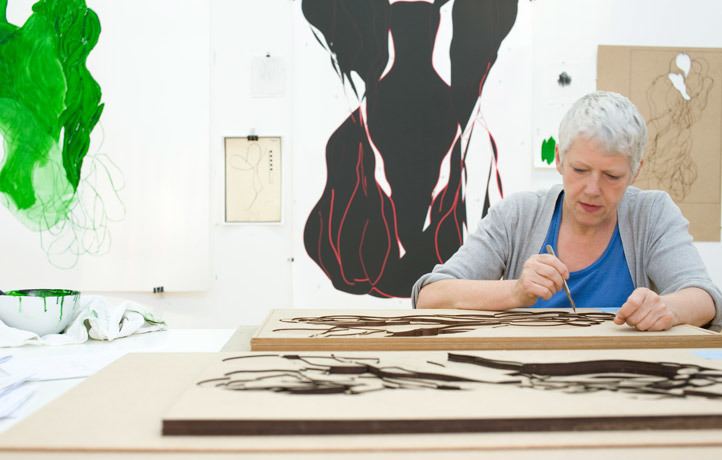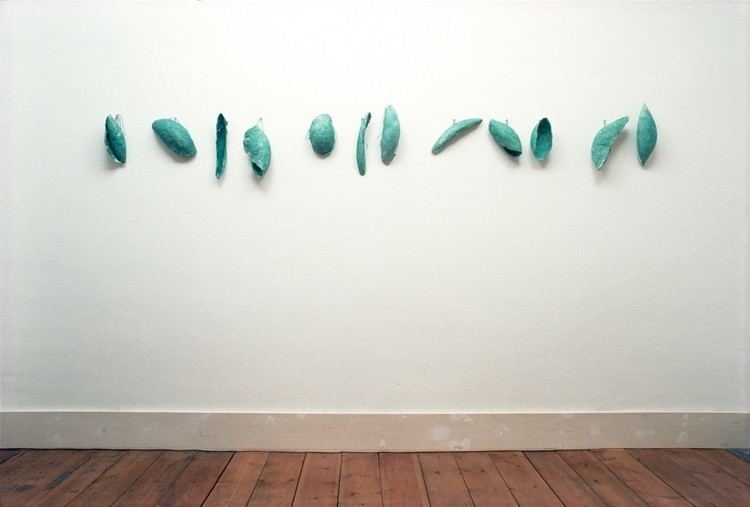Nationality British Role Artist | Name Susanna Heron | |
 | ||
Awards Honorary Fellow of the RIBA Books Shima: Island and Garden, Stills from Sculpture | ||
40 Chancery Lane London: Scene Setting for Travertine Frieze by Susanna Heron
Susanna Heron (b. 1949 – ) hon FRIBA is a British artist who works primarily between drawing, sculpture, scale and movement.
Contents
- 40 Chancery Lane London Scene Setting for Travertine Frieze by Susanna Heron
- Site Specific Art protecting the artists vision
- Life and work
- Commissioned works
- References

Site Specific Art - protecting the artist's vision
Life and work

Heron was born in Welwyn Garden City in 1949. Her family moved from London to Eagles Nest, Cornwall in 1955. She is the younger daughter of the painter Patrick Heron and Delia Heron (née Reiss ) and sister of architect Katharine Heron. She was educated at Penzance Girls Grammar School and studied at Falmouth School of Art 1967-68 and Central Saint Martins School of Art, London 1968-1971.

Between 1966-83 Heron received international recognition as a major presence in British New Jewellery. Her works were not immediately discernible as jewellery instead Heron made a series of works which extended the body to articulate the surrounding space through movement and proportion.
In 1977 Heron was awarded UK/US Bicentennial Arts Fellowship (British Council/N.E.A.) to travel and work in the USA for one year.
In 1981 Heron made ‘The Wearables’ (Stedelijk Museum Collection.), a series of works consisting of flat discs tied to the body. These were a group of works to be worn like clothing, or to be exhibited with the idea of wearing them. ‘The Wearables’ were exhibited on the wall alongside photographs created with David Ward and ‘offered a new meditation and reflection on the conditions for jewellery and body wear’
‘The Wearables’ were the last works Heron made to be worn and led to a new beginning in sculpture. The peripatetic body continued to be the measure in her work. By filling the spaces for the body the works could no longer be worn and rather addressed the architectural qualities of the room. ‘Frieze’ 1983-84 (Papier-mâché and aluminium leaf wall piece 41 x 343 cm, height from floor 2.5m) was shown in her first sculpture exhibition at Whitechapel Art Gallery in 1985. Followed by exhibitions at Plymouth Arts Centre (1986), The Showroom (1987), Camden Arts Centre (1989) and Newlyn Art Gallery (1992).
Heron became involved in the regeneration of Will Arnold Forster's garden at Eagles Nest in 1987. She exhibited a series of related works in 1992 including engravings on slate salvaged from pool tables, and Shima: Island and Garden a book and series of cibachrome photographs. (Arts Council Collection)
In 2002 Heron made the 'Elements' drawings a series of ink drawings originally made for a commission in Tokyo in 2001 but which have evolved as a body of work to be recreated and transformed by location, scale and substance. 'The 'Elements' drawings… are in a sense metaphors for scale and for time. Like mathematical systems, they are elements, essences, reproducible at any size. They can be used in the building in Tokyo, in a London street, on the walls of a gallery or as tiny prints. Like found objects they are transportable; but the experience of the works is specific, rooted in a particular time and place.'. In 2002 Heron exhibited 'Elements' a site specific installation of large scale wall drawings for the Warwick Arts Centre.
Commissioned works
In 1995 Heron completed her first site specific commission 'Slate Frieze', 23 rectangular slabs of engraved slate over a 21m length wall in the Council of the European Union, Brussels. This was closely followed by her first landscape works 'Island', a work in three parts along a path (by coincidence another 21m length) for the new British Embassy in Dublin and 'Sunken Courtyard', Hackney College London.
Other site specific works and collaborations followed including: 'Waterwindow' 1998 - 2003, a waterfall sited at the change in levels between Priory Garden and Priory Place in Coventry; '36 Elements: Glass Wall' 2001-2002, a 50 ft structural glass wall for the Shin-Marunouchi Building in Tokyo, sandblasted and etched with 36 drawings from the Elements series; and between 2001-2003 'Side Street' a covered pedestrian passage linking Millbank to John Islip Street incorporating four vertical panels of slate with engravings for City Inn, Westminster.
In 2003 Heron was commissioned to create 'Aquaduct', a choreographic landscape work incorporating running water for the central space of The Brunswick Centre in Bloomsbury, completed in 2006. In this period Heron was also commissioned for a major external artwork titled 'Still Point' in the lea of Liverpool Metropolitan Cathedral between 2004 – 2007 and a new work titled 'Roche' a negative relief in glass and bronze for the facade of the House of Fraser in Cabot Circus, Bristol between 2005-2008.
In 2009 Heron was commissioned to make a new work titled 'Henslow’s Walk' for the Sainsbury Laboratory opened in 2011. 'Employing her favoured medium of drawings in shallow relief, Heron has created a backdrop to the Laboratory’s lecture theatre intricately carved into the yellow French limestone, which forms part of the fabric of the building. Heron builds a poetic narrative that allows a work to be explored depending on the subjective engagement of the observer. Not unlike the tracery of a palimpsest each paired drawing appears as though connected by an invisible presence.'
